Guppies, with their vibrant colors and graceful swimming, are a popular choice among aquarium enthusiasts. If you have ever wondered about the fascinating world of guppy breeding, you have come to the right place.
In this complete guide, we will explore everything you need to know about breeding guppies, from understanding their life cycle to overcoming common challenges.
So, let’s dive in and explore the wonderful world of guppy breeding!
Understanding Guppy Breeding
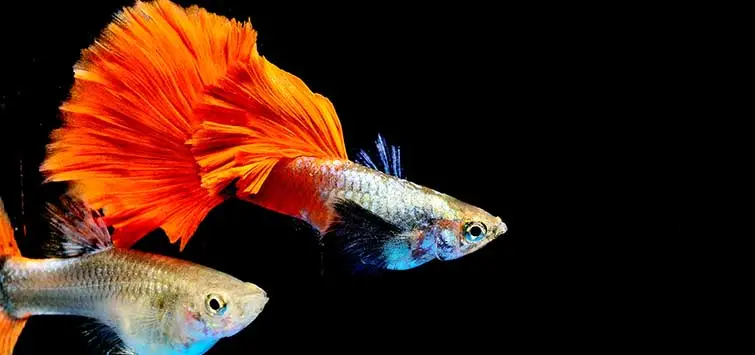
If you want to become a successful guppy breeder, it’s essential to understand the basics of their breeding behavior.
Guppies are livebearers, which means they give birth to live, fully-formed fry instead of laying eggs. This unique reproductive method contributes to their popularity in the aquarium hobby.
The Life Cycle of Guppies: Guppies go through a fascinating life cycle. The female guppy becomes sexually mature at around two to three months old and can give birth to a batch of fry every 30 days.
This reproductive capability allows for a continuous cycle of new generations in the aquarium. The fry are initially small and vulnerable, but they grow rapidly under the right conditions.
As they mature, their colors and patterns become more pronounced, adding vibrancy to the aquarium.
Male guppies, on the other hand, are known for their vibrant colors and flowing fins, making them easy to distinguish from females. These striking physical features are a result of sexual selection, where females prefer mates with more elaborate displays.
The males’ slender bodies and long, colorful fins are not only visually appealing but also serve a purpose in courtship and mating.
Male vs. Female Guppies: Males typically have slender bodies and long, colorful fins, while females are larger and have shorter fins. These distinct physical characteristics play an important role in courtship and mating.
When a male guppy encounters a female, he will display his vibrant colors and fins in an elaborate courtship dance. This dance is a way for the male to attract the female’s attention and demonstrate his fitness as a potential mate.
If the female is receptive, she will respond by displaying her own subtle color changes and body movements.
Once the courtship is successful, the male will position himself next to the female and use a specialized fin called a gonopodium to transfer sperm into the female’s body.
This process, known as internal fertilization, ensures that the female’s eggs are fertilized and ready for development. The fertilized eggs will then undergo a gestation period inside the female’s body, where they receive nourishment from a yolk sac.
This period typically lasts for around 28 days, during which the female’s abdomen gradually swells as the fry grow.
When the fry are fully developed, the female guppy will give birth to a batch of live, independent fry. The number of fry can vary, with some females giving birth to as few as 20 fry and others producing over 100.
The fry are immediately capable of swimming and feeding on their own, although they are still vulnerable to predation. To increase their chances of survival, it is recommended to provide hiding places and ample vegetation in the aquarium for the fry to seek shelter.
Understanding the intricacies of guppy breeding not only allows for successful reproduction but also provides a deeper appreciation for these fascinating creatures.
By creating an environment that mimics their natural habitat and ensuring proper care, guppy breeders can witness the wonder of new life unfolding in their aquariums.
Preparing for Guppy Breeding

Before embarking on your guppy breeding adventure, it’s crucial to ensure that you provide a suitable environment for these tropical fish. Here are some key factors to consider:
Choosing the Right Aquarium
When considering choosing the right aquarium for your guppy breeding endeavors, several factors come into play. Firstly, tank size is critical. Opt for a tank that provides enough space for your guppies to thrive and grow comfortably. Ensure it is large enough to accommodate a breeding tank if you plan to engage in breeding guppies.
Water quality is paramount in maintaining a healthy environment for your guppies. Invest in a high-quality fish tank equipped with appropriate filtration systems, such as a sponge filter, to keep the water clean and clear. This helps prevent issues like excess food buildup and maintains the overall health of your guppy fry.
Consider the temperature requirements of guppies. An aquarium heater may be necessary to regulate the water temperature within the optimal range for guppy breeding and overall well-being.
Take into account the compatibility of guppies with other fish species if you plan to keep them in a community tank. Some guppy parents may become aggressive towards other tankmates, especially during pregnancy or while caring for baby guppies.
Incorporate aquatic plants like java moss to provide hiding spots for fry and enhance the aesthetic appeal of the tank. These plants also contribute to water quality by absorbing excess nutrients.
Regular maintenance is essential to keep the aquarium clean and healthy. Perform tank clean regularly to remove any debris or waste that may accumulate. Monitor the health of your guppies closely and address any issues promptly to ensure they remain in top condition.
By carefully considering these factors, you can create an ideal environment for keeping guppies and breeding guppies successfully.
Optimal Water Conditions for Guppies
Additionally, guppies prefer slightly alkaline water with a pH level around 7.2 to 7.8. Regular water testing and the use of a reliable water conditioner will help to maintain optimal water quality.
It’s important to note that water temperature plays a crucial role in the breeding success of guppies. The warmer the water, the faster the guppies’ metabolism, which can lead to increased breeding activity.
However, it’s essential to avoid extreme temperature fluctuations, as this can cause stress and potentially harm the guppies.
In addition to temperature, water quality is also a significant factor in guppy breeding. Guppies are sensitive to changes in water chemistry, so it’s essential to monitor and maintain the appropriate pH level.
A pH level that is too low or too high can negatively impact the health and breeding behavior of the guppies. Regular water testing and the use of a water conditioner specifically designed for tropical fish can help to stabilize the pH level and ensure a suitable environment for breeding.
Furthermore, it’s important to consider the water hardness when breeding guppies. Guppies prefer slightly hard water, as it mimics their natural habitat.
If the water is too soft, it may be necessary to add minerals or use a water conditioner that can adjust the water hardness to meet the guppies’ needs.
Overall, creating and maintaining optimal water conditions is crucial for successful guppy breeding. By providing the right temperature, pH level, and water hardness, you can ensure that your guppies are healthy, happy, and ready to breed.
The Breeding Process
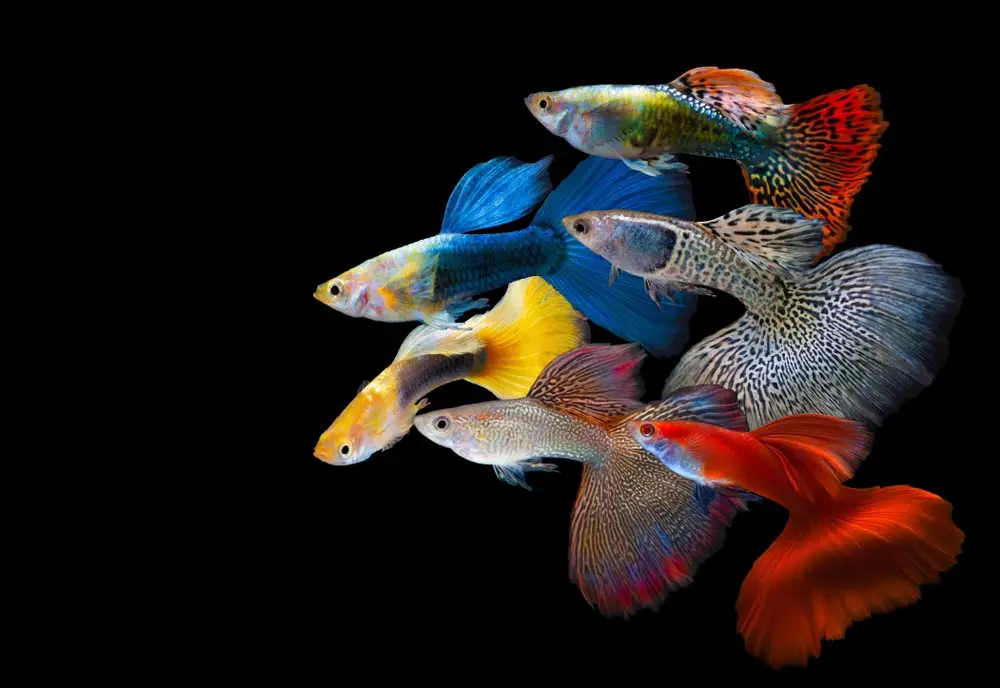
Now that you have prepared the perfect setting for guppy breeding, it’s time to dive into the exciting process itself. Understanding the intricacies of selecting guppies for breeding and their mating rituals is crucial for successful reproduction.
Selecting Guppies for Breeding
When selecting guppies for breeding, it’s important to consider various factors. Look for healthy males and females with vibrant colors and no signs of illness.
Avoid breeding closely related guppies to prevent genetic issues in the offspring. Introducing new bloodlines can help maintain the overall health and vigor of the fry.
When it comes to selecting guppies for breeding, there are certain traits that breeders often look for. For example, some breeders may prioritize guppies with unique color patterns or striking fin shapes.
Others may focus on guppies with specific tail types, such as the fan-shaped delta tail or the flowing veil tail. By selectively breeding guppies with these desired traits, breeders can create new and visually stunning varieties.
Another important consideration when selecting guppies for breeding is their overall health and vitality. Guppies that are robust and free from any signs of illness or deformities are more likely to produce healthy offspring.
It’s also essential to observe the behavior of potential breeding guppies. Look for individuals that are active, alert, and show no signs of aggression towards other fish in the tank.
The Mating Ritual of Guppies
Guppies have a fascinating courtship and mating ritual. Male guppies display their colorful fins and perform elaborate dances to attract females. This courtship behavior is known as “flashing.”
The male guppy flares his fins, showing off his vibrant colors and intricate patterns, in an attempt to catch the attention of the females.
During the courtship display, the male guppy also performs a series of acrobatic movements, swimming in a zigzag pattern or darting back and forth.
These movements not only showcase the male’s agility but also serve as a way to mesmerize the female guppies. The more impressive the display, the more likely the male is to attract a mate.
When the female guppy is receptive, the male will attempt to fertilize her by using a specialized fin called the gonopodium. The gonopodium is a modified anal fin that has evolved into a structure specifically designed for transferring sperm.
It is elongated and slender, allowing the male to insert it into the female’s reproductive opening.
Successful fertilization occurs when the male releases sperm from his gonopodium and it is transferred to the female’s oviduct. The female guppy has the ability to store sperm for several months, allowing her to fertilize multiple batches of eggs without the presence of a male.
This adaptation ensures that the female can continue to reproduce even in the absence of a suitable mate.
Once fertilization has taken place, the female guppy enters a pregnancy period that typically lasts for around 4 to 6 weeks. During this time, the female’s belly gradually swells as the embryos develop inside her.
Guppy fry are born live, as opposed to hatching from eggs, and are fully formed miniature versions of their parents.
It’s important to note that guppies are known for their prolific breeding abilities. A single female guppy can give birth to dozens of fry in a single brood. This high reproductive capacity has made guppies a popular choice for hobbyists and breeders alike.
Post-Breeding Care
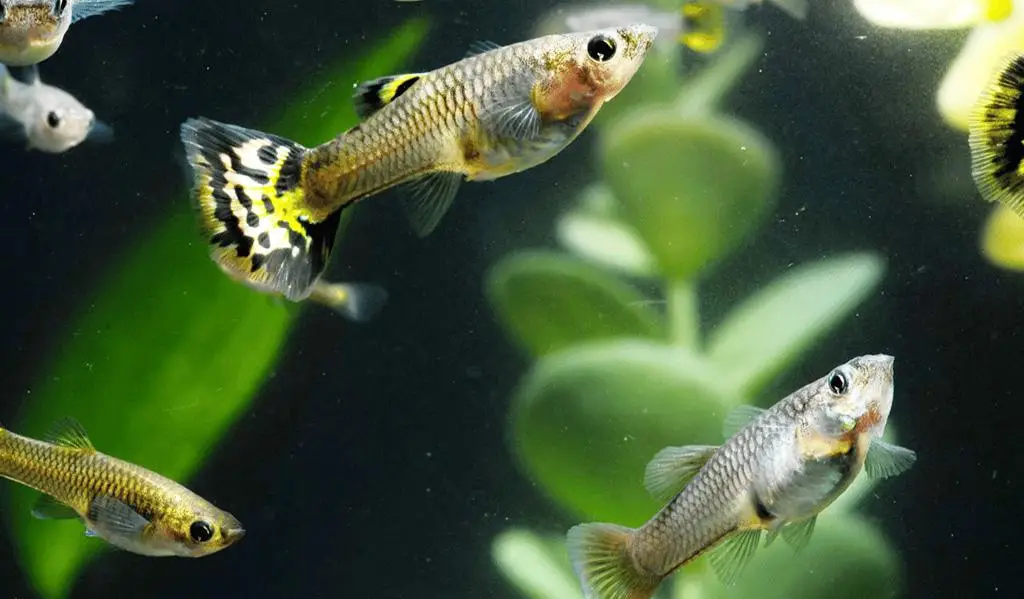
After successful mating, proper care for pregnant females and raising guppy fry is essential for their well-being. Let’s explore some vital aspects of post-breeding care.
Caring for Pregnant Guppies
Pregnant guppies require extra care and attention. Providing them with a separate breeding tank allows for easy monitoring and isolation.
This tank should be spacious enough to accommodate the pregnant female comfortably. It is important to maintain the water temperature within the optimal range of 72-82°F (22-28°C) to ensure the well-being of the pregnant guppy.
Additionally, the tank should be equipped with suitable hiding spots, such as dense vegetation or floating plants, to provide a sense of security for the pregnant female. These hiding spots not only offer protection but also mimic their natural habitat, reducing stress levels.
During pregnancy, guppies have increased nutritional needs. Offering a nutritious diet rich in high-quality flakes, freeze-dried or live foods will support their health during this crucial period.
Providing a varied diet that includes protein-rich foods like brine shrimp or daphnia can help ensure the pregnant guppy receives all the necessary nutrients for a successful pregnancy.
It is important to feed them small portions multiple times a day to prevent overeating and maintain water quality.
As the pregnancy progresses, the female guppy’s abdomen will visibly enlarge. This is a sign that she is nearing the end of her gestation period.
It is important to monitor her closely during this time, as she may experience difficulties giving birth. If you notice any signs of distress or prolonged labor, it may be necessary to seek veterinary assistance.
Raising Guppy Fry
Once the female gives birth, it’s essential to provide appropriate care for the fry. Guppy fry are born fully formed, capable of swimming and feeding independently.
However, they are still vulnerable to predation, so it is crucial to provide adequate hiding spots in the breeding tank.
This can be achieved by adding fine-leaved plants or artificial spawning mops. These hiding spots not only provide protection but also mimic the natural environment of the fry, making them feel more secure.
Water conditions play a crucial role in the growth and development of guppy fry. The water temperature should be maintained between 75-80°F (24-27°C) to ensure optimal growth. It is important to regularly monitor the water parameters, including pH, ammonia, nitrite, and nitrate levels, to maintain a healthy environment for the fry.
Performing regular water changes and using a reliable water conditioner will help keep the water quality stable.
Feeding the guppy fry is a critical aspect of their care. Initially, they can be fed finely crushed flakes or specialized fry food. As they grow, their diet can be gradually transitioned to include newly hatched brine shrimp or microworms.
It is important to feed them small amounts several times a day to ensure they receive adequate nutrition for their rapid growth. Overfeeding should be avoided, as it can lead to poor water quality and health issues.
As the fry continue to grow, you may notice differences in coloration and fin development. This is an exciting time as you start to see the unique characteristics of each individual guppy.
It is important to provide a stimulating environment by adding plants and decorations to the tank. This not only enhances their well-being but also encourages natural behaviors and exploration.
Remember, raising guppy fry requires patience and dedication. By providing proper care, a suitable environment, and a nutritious diet, you can ensure the healthy growth and development of your guppies.
Common Challenges in Guppy Breeding
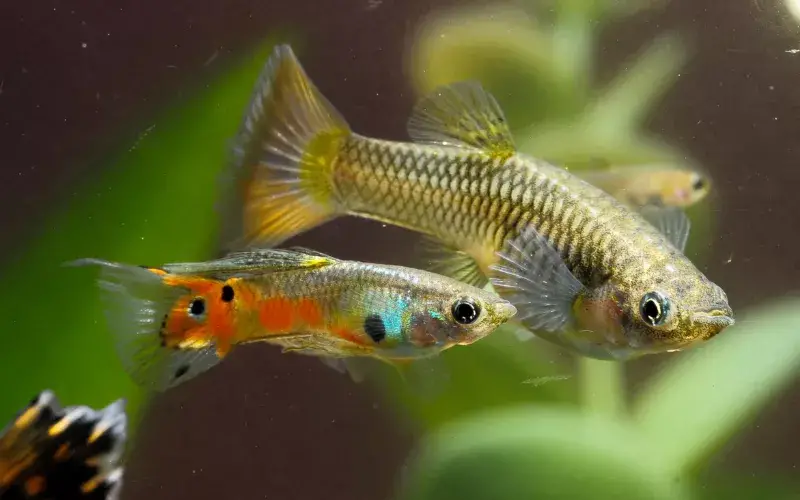
While guppy breeding can be a rewarding experience, it’s not without its challenges. Here are a couple of common issues that you may encounter:
Dealing with Aggressive Guppies
In a breeding tank, male guppies may display aggression towards females or other males. This aggression can result in stressed and injured fish.
Providing ample hiding spots and separating aggressive individuals can help mitigate these issues. Dividing the tank using a mesh or installing separate breeding compartments can also be effective solutions.
Aggression in guppies is often influenced by factors such as overcrowding, competition for resources, and territorial disputes. It is important to create a harmonious environment for your guppies to thrive.
Adding plants and decorations to the tank not only enhances the aesthetic appeal but also provides hiding places for the females to escape the relentless pursuit of males.
Additionally, observing the behavior of your guppies can give you valuable insights into their social dynamics. Some males may exhibit more aggressive behavior than others, and it may be necessary to remove the most aggressive individuals from the breeding tank to maintain a peaceful environment.
Preventing Common Diseases in Guppies
Guppies are susceptible to various diseases, such as fin rot, ich, and fungal infections. Maintaining excellent water quality, performing regular water changes, and proper filtration are essential for preventing diseases.
Quarantining new fish before introducing them to the breeding tank helps reduce the risk of introducing pathogens to the existing population.
Water quality plays a crucial role in the overall health of guppies. Ammonia and nitrite levels should be kept at zero, and nitrate levels should be kept as low as possible. Regular testing of water parameters and taking appropriate measures to maintain optimal conditions are vital for disease prevention.
In addition to water quality, a balanced diet is essential for boosting the immune system of guppies. Providing a varied diet that includes high-quality flakes, pellets, and live or frozen foods will help ensure that your guppies receive all the necessary nutrients to stay healthy and disease-resistant.
Furthermore, maintaining a clean and well-maintained breeding tank is crucial. Regularly removing uneaten food, decaying plants, and waste will help prevent the accumulation of harmful bacteria and parasites that can lead to diseases.
Proper filtration, including mechanical and biological filtration, aids in removing impurities and maintaining a stable and healthy environment for your guppies.
Enhancing Guppy Breeding Success
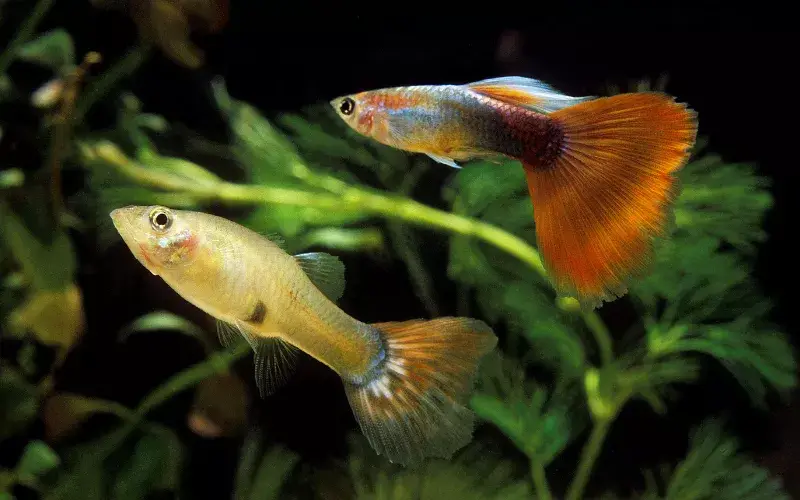
To ensure successful breeding and the well-being of your guppies, consider the following tips:
Feeding and Nutrition Tips for Guppies
Providing a balanced and varied diet is crucial for the health of your guppies. Along with high-quality flakes, supplement their diet with protein-rich foods such as live or frozen brine shrimp, daphnia, or bloodworms.
Offering a variety of foods helps mimic their natural diet and promotes vibrant colors and robust immune systems.
Tips for Increasing Guppy Lifespan
Guppies have an average lifespan of one to three years, but with proper care, you can increase their longevity. Maintain optimal water conditions, perform regular water changes, and avoid overstocking the tank to reduce stress on the fish.
Additionally, providing a well-balanced diet and a stress-free environment greatly contributes to their overall health and well-being.
Conclusion
Breeding guppies can be a rewarding and captivating journey. From understanding their unique breeding behavior to providing a suitable environment and caring for the fry, each step contributes to the success and well-being of these vibrant tropical fish.
By following this complete guide, you’ll be well on your way to becoming a skilled guppy breeder and fostering the beauty and vitality of these delightful aquatic creatures.
Happy breeding!

